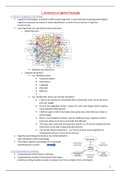1. Introduction to Cognitive Psychology
1.1 What is Cognitive Psychology?
➢ Cognitive Psychology is a discipline within psychology that is concerned with studying psychological
cognitive processes, by means of observing behavior, as well as brain activity (~Cognitive
neuroscience).
➢ Learning things can’t go without brain processes:
o Mental process:
▪ (Behaviorists: black box)
o Separate processes?:
▪ E.g.: Reading a book:
• Visual perception
• Instructions
• Language
• Attention
• Memory
• …
▪ E.g.: Simple task: Senne, go and buy tomatoes!
• I rely on my memory to remember what I should buy until I am at the store
(Van der Jeugd)
• Once at the vegetable section, I search for red round shapes which requires
visual attention (Marzecová)
• I feel the urge to follow my habits and quickly buy some delicious candy as
well (Lesage)
• Damn, I just dropped a tomato, and my cellphone rings. Cognitive control
processes allow me to focus and multi-task (Braem)
• The shop uses a new self-scan payment system, so I’ll need to implement new
instructions to be able to pay (González-García)
• I do not get these instructions..., so I’ll just use basic social cognition by
imitating the person in front of me (Cracco)
➢ Cognitive psychology has become very (inter)related to
other disciplines within psychology
➢ This makes cognitive psychology an increasingly
multidisciplinary science
1.2 Computational modelling
➢ Computational power keeps increasing:
➢ Computationel models (reinforcement learning or
predictive coding models) are able to explain ever more complex forms of behavior
1
,1.3 Cognitive neuroscience
➢ We are in the middle of a cognitive neuroscience revolution:
o Between 2000 and 2010 the fMRI method wasn’t developed
enough therefore we should always be critical enough when
using those studies
➢ The use of neuroimaging techniques is exponentially increasing, and
analysis techniques are still being (re)developped today
➢ Functional specificity
(hierarchical):
➢ Themes:
➢ Neurosynth (http://neurosynth.org/):
o Meta-analyses (Terms): Search a term and find out with which location it is associated most
o Location: Enter x y z (MNI) coordinates and find out with which regions this location shows
most coactivation or connectivity, and with which terms it is associated most
o Read the FAQ for a correct interpretation
➢ Please note that, despite a functional specialization, researchers are increasingly thinking in terms of
brain networks or systems rather than regions to explain brain and behavior:
o Systems neuroscience:
▪ Brain networks rather than regions
▪ Analysis techniques focus more and more on patterns of activation, rather than mean
activation (MVPA, connectivity pattern analyses, EEG decoding)
▪ Gene-behavior relations are distributed and multifunctional (pleiotropy & poligenicity)
▪ Neurotransmitters (e.g., dopamine, noradrenaline) have systemwide effects and
constantly interact with one another
1.4 Clinical and Cognitive Psychology
➢ The study of mental concepts also allows us to understand certain clinical disorders better (but also
the other way around!), for example:
o Cognitive control and autism
o Memory research and dementia
o Research on instructions and goal neglect
o Research on habits and gambling disorders
1.5 Conclusion
➢ Take home message = The themes of Cognitive Psychology II are not “exclusive”!
➢ Different themes will discuss different stadia of information processing in the brain!
2
, 2. What controls cognitive control?
➢ Cognitive control is necessary to make achieving our goals easier
➢ Originally, cognitive control was conceptualized as a unitary function, and outsourced to single
modules such as:
o The "central executive" (Baddeley, 1986)
o The "supervisory attentional system” (Norman & Shallice, 1986)
➢ By the late nineties, it was recognized that cognitive control consists of more than just one broad
regulatory function (e.g., Miyake et al., 2000; Diamond, 2013)
➢ Today, different functions have been stripped down, such as:
o Working memory (Oberauer et al., 2018, Psychol. Bull.)
o Conflict adaptation (Braem et al., 2019, TiCS)
o Cognitive flexibility (Koch et al., 2018, Psychol. Bull.)
o Response inhibition (Verbruggen et al., 2019, eLife)
2.1 Conflict adaptation
➢ Imagine that you’re bicycling and you have to make a right turn...
In the congruent situation
we will be faster to
respond than in the
incongruent one, which
has task irrelevant
information, it interferes
with your choice.
3
, ➢ Imagine you have to press right when you see the letter S...
➢ Imagine you have to press right when you see the color green...
➢ The difference in reaction times between the incongruent (difficult) and congruent (easy) trials is
called the congruency effect:
The green one is
the difference
between the 2 blue
ones.
➢ This congruency effect tends to be smaller after incongruent than after congruent trials (Gratton et al.,
1992):
o = Gratton effect (Gratton et al., 1992) = Congruency sequence effect
o = Conflict adaptation effect
o E.g.: Stroop task: when the previous trial was incongruent the participant had no benefit in
reading the word, when you get the next trial (which is congruent) you’ll automatically think
the same but as a matter of facts here you would benefit from reading the word
➢ The detection of conflict is thought to occur in the ACC (Fig. A)...
...and the adaptation on the next trial in
the dlPFC (Fig. C)
4




